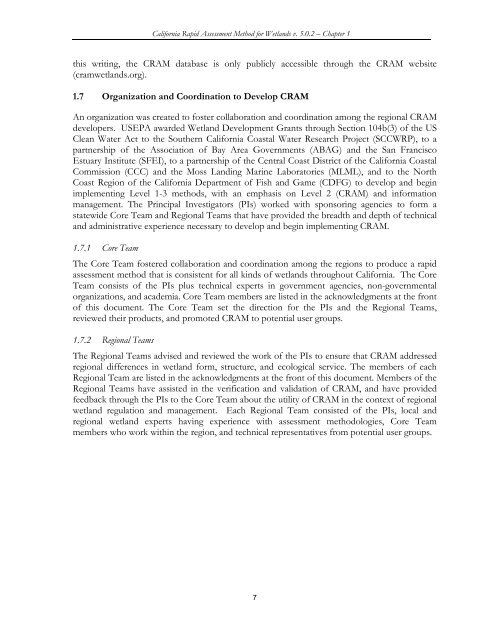(CRAM) For Wetlands User's Manual Version 5.0.2
(CRAM) For Wetlands User's Manual Version 5.0.2
(CRAM) For Wetlands User's Manual Version 5.0.2
Create successful ePaper yourself
Turn your PDF publications into a flip-book with our unique Google optimized e-Paper software.
California Rapid Assessment Method for <strong>Wetlands</strong> v. <strong>5.0.2</strong> – Chapter 1<br />
this writing, the <strong>CRAM</strong> database is only publicly accessible through the <strong>CRAM</strong> website<br />
(cramwetlands.org).<br />
1.7 Organization and Coordination to Develop <strong>CRAM</strong><br />
An organization was created to foster collaboration and coordination among the regional <strong>CRAM</strong><br />
developers. USEPA awarded Wetland Development Grants through Section 104b(3) of the US<br />
Clean Water Act to the Southern California Coastal Water Research Project (SCCWRP), to a<br />
partnership of the Association of Bay Area Governments (ABAG) and the San Francisco<br />
Estuary Institute (SFEI), to a partnership of the Central Coast District of the California Coastal<br />
Commission (CCC) and the Moss Landing Marine Laboratories (MLML), and to the North<br />
Coast Region of the California Department of Fish and Game (CDFG) to develop and begin<br />
implementing Level 1-3 methods, with an emphasis on Level 2 (<strong>CRAM</strong>) and information<br />
management. The Principal Investigators (PIs) worked with sponsoring agencies to form a<br />
statewide Core Team and Regional Teams that have provided the breadth and depth of technical<br />
and administrative experience necessary to develop and begin implementing <strong>CRAM</strong>.<br />
1.7.1 Core Team<br />
The Core Team fostered collaboration and coordination among the regions to produce a rapid<br />
assessment method that is consistent for all kinds of wetlands throughout California. The Core<br />
Team consists of the PIs plus technical experts in government agencies, non-governmental<br />
organizations, and academia. Core Team members are listed in the acknowledgments at the front<br />
of this document. The Core Team set the direction for the PIs and the Regional Teams,<br />
reviewed their products, and promoted <strong>CRAM</strong> to potential user groups.<br />
1.7.2 Regional Teams<br />
The Regional Teams advised and reviewed the work of the PIs to ensure that <strong>CRAM</strong> addressed<br />
regional differences in wetland form, structure, and ecological service. The members of each<br />
Regional Team are listed in the acknowledgments at the front of this document. Members of the<br />
Regional Teams have assisted in the verification and validation of <strong>CRAM</strong>, and have provided<br />
feedback through the PIs to the Core Team about the utility of <strong>CRAM</strong> in the context of regional<br />
wetland regulation and management. Each Regional Team consisted of the PIs, local and<br />
regional wetland experts having experience with assessment methodologies, Core Team<br />
members who work within the region, and technical representatives from potential user groups.<br />
7















